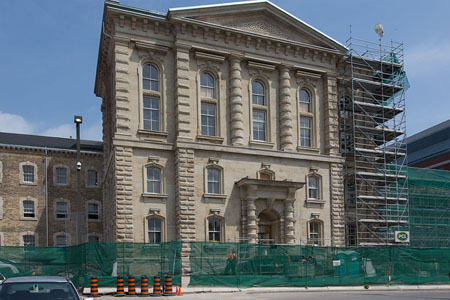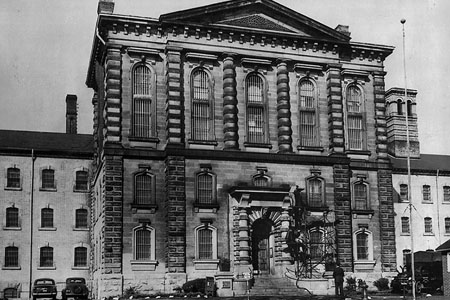This article is from our Toronto Feature series. Features from past programs are not updated.
This content is from a series created in partnership with Museum Services of the City of Toronto and Heritage Toronto. We gratefully acknowledge funding from the Ontario Ministry of Tourism, Culture and Sport, and the Department of Canadian Heritage.
"The Old Don Jail, Cursed From the Start"
The stern countenance of Father Time glares stonily from the keystone above the iron-studded oak door of the Old Don Jail. The architectural feature was intended to instill fear in those who crossed the threshold. His face could well be the disgruntled expression of the building itself, for if ever a building was cursed from its inception, it was the Don.
The Don Jail was designed by William Thomas, architect of some of Toronto's finest buildings of the period, including St Lawrence Hall. Thomas died before the building was completed in 1865, and one wonders if the stress of building it didn't wear him out. The job took 7 years from drawing to completion, suffered huge cost overruns with construction delayed by politics and contractors, had a flawed foundation that had to be redone, and was largely destroyed by fire as it neared completion (insurance didn't cover reconstruction).
Built on the 19th century's progressive theories of penal reform, the jail's narrow cells were intended mainly for sleeping. Prisoners were intended to work in workshops, classrooms or the jail's surrounding industrial farm for much of the day. But things didn't work out as planned. Changing philosophies left prisoners in their cells and the Old Don became a vermin-infested hell-hole described as a dungeon and "a black cesspool unfit for human habitation." The chronic overcrowding caused the spread of diseases such as tuberculosis. Worse, it was the site of 34 executions by hanging (the last were Ronald Turpin and Arthur Lucas of the Boyd Gang in 1962), several suicides, and is said to be haunted by a young woman prisoner who hanged herself in the 1890s.
The adjoining New Don Jail opened in 1958; the Old Don was closed in 1977 and the inmates moved into the new section. Photos showed dignitaries with sledgehammers symbolically taking a swing at the despised symbol of cruelty.
Today, the building is a riveting city landmark, recognized for its stunning, purposeful architecture, as well as for its storied past.
See also Prison Architecture.

 Share on Facebook
Share on Facebook Share on X
Share on X Share by Email
Share by Email Share on Google Classroom
Share on Google Classroom





